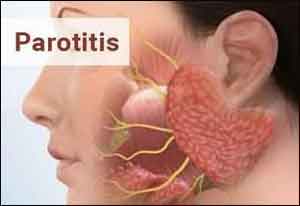- Home
- Editorial
- News
- Practice Guidelines
- Anesthesiology Guidelines
- Cancer Guidelines
- Cardiac Sciences Guidelines
- Critical Care Guidelines
- Dentistry Guidelines
- Dermatology Guidelines
- Diabetes and Endo Guidelines
- Diagnostics Guidelines
- ENT Guidelines
- Featured Practice Guidelines
- Gastroenterology Guidelines
- Geriatrics Guidelines
- Medicine Guidelines
- Nephrology Guidelines
- Neurosciences Guidelines
- Obs and Gynae Guidelines
- Ophthalmology Guidelines
- Orthopaedics Guidelines
- Paediatrics Guidelines
- Psychiatry Guidelines
- Pulmonology Guidelines
- Radiology Guidelines
- Surgery Guidelines
- Urology Guidelines
Acute Parotitis- Standard Treatment Guidelines

Parotitis is an inflammation of one or both parotid glands, the major salivary glands located on either side of the face, in humans. The parotid gland is the salivary gland most commonly affected by inflammation.
Ministry of Health and Family Welfare, Government of India has issued the Standard Treatment Guidelines for Mouth Ulcers. Following are the major recommendations:
CAUSES :
Infectious parotitis
Acute bacterial parotitis:
Parotitis as Extrapulmonary
Tuberculosis:
Acute viral parotitis (mumps):
HIV parotitis:
Autoimmune causes
These are also collectively known as chronic punctate parotitis or chronic autoimmune parotitis.
Sjögren's syndrome:
Mikulicz disease:
Lymphoepithelial lesion of Godwin:
Blockage
Blockage of the main parotid duct, or one of its branches, is often a primary cause of acute parotitis, with further inflammation secondary to bacterial superinfection. The blockage may be from a salivary stone, a mucous plug, or, more rarely, by a tumor, usually benign.
Chronic nonspecific parotitis:
Recurrent parotitis of childhood
Sialadenosis (sialosis):
Sarcoidosis:
Pneumoparotitis:
Symptoms
- Abnormal tastes, foul tastes
- Decreased ability to open the mouth B
- Dry mouth
- Fever DDD. Mouth or facial pain, especially when eating
- Redness over the side of the face or the upper neck
- Swelling of the face (particularly in front of the ears, below the jaw, or on the floor of the mouth)
Signs and tests
An examination by the health care provider or dentist shows enlarged salivary glands. Pus may drain into the mouth. The gland may be painful, particularly with bacterial infections. Viral infections such as mumps may cause painless swelling of the glands. A CT scan or ultrasound may be done if the doctor suspects an abscess.
Treatment
In some cases, no treatment is necessary.
If there is pus or a fever, or if the infection is known or thought to be bacterial, antibiotics may be prescribed. Antibiotics are not effective against viral infections.
If there is an abscess, surgical drainage or aspiration may be done.
Good oral hygiene, with thorough tooth brushing and flossing at least twice per day, may aid healing and help prevent an infection from spreading. If you are a smoker, stop smoking as it helps in recovery.
Warm salt water rinses (1/2 teaspoon of salt in one cup of water) may be soothing and keep the mouth moist.
Drink lots of water and use sugar-free lemon drops to increase the flow of saliva and reduce swelling. Massaging the gland with heat may help.
Guidelines by The Ministry of Health and Family Welfare :
Dr J M Hans Ex-HOD Dept. of Otorhinolaryngology Dr.RML Hospital New Delhi

Disclaimer: This site is primarily intended for healthcare professionals. Any content/information on this website does not replace the advice of medical and/or health professionals and should not be construed as medical/diagnostic advice/endorsement or prescription. Use of this site is subject to our terms of use, privacy policy, advertisement policy. © 2020 Minerva Medical Treatment Pvt Ltd